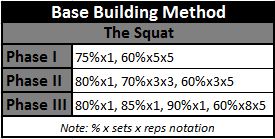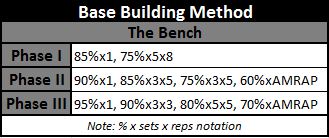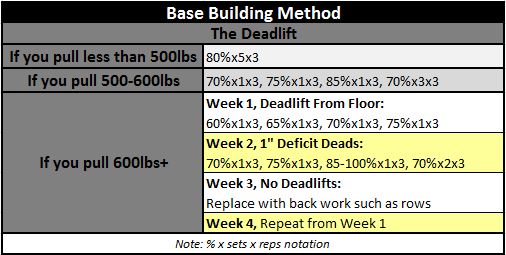As the programming series heads towards wrap-up, and we review these last couple of methodologies, the next target of our focus is Paul Carter’s Base Building Manual. Base Building is about 80 pages long and, more than a specific program, it contains Paul Carter’s general philosophy and programming tool kit. In other words, this is not the book you want to snag if you’re looking for a “cookie cutter” template to follow; this is a book to snag if you’re looking for a general philosophy that you’ll meld to your own individuality over time.
While I love many of the ideas in the manual, especially Carter’s thoughts on psychological approaches to lifting and progress, the overall programmatic structure he espouses runs counter to many of my personal biases regarding optimal programming. Remember, there is no “Base Building Method”; this is a collection of ideas and tools that you must forge into a coherent program yourself. Base Building is more of a system than a program.
In the rest of this review, we’ll take a critical look at the strengths and weaknesses of the “system” for powerlifting purposes.
If you’d rather watch than read:
A Rant on Powerlifting Programs
WARNING! Skip this section if you just want to get into the details of the program review.
Unfortunately, due to the lack of emphasis and clarity in my writing, a lot of people have gotten the wrong idea about this programming series. Many of my readers seem to think that I am passing judgment as to whether these are “good” or “bad” programs. That couldn’t be further from the truth.
As a detailed obsessed, process-oriented nerd, what I am attempting to do here is analyze the minutiae that separate many of the popular programs. Remember, in this entire review series, we are not proceeding from a place of “X program does/doesn’t work” or even “X program is good/bad”; we’re proceeding from a place, for the most part, of “good, better, best”. If a program rates fairly well on specificity, overload, and fatigue management, it doesn’t matter if the rest of the practices are not optimal. So long as you work hard, you’ll get great results.
Look, exceptional athletes are exceptional for intangible reasons… not strictly because of which program they choose. Michael Jordan would have dominated the NBA even if he was using the most retarded program you could possibly imagine. Why? Because he’d still have everything that made him Michael Jordan: insane competitiveness, the will to win, killer instinct, and all of the other sports cliches that you can think of.

I’m willing to bet a lot of money that Michael Jordan would’ve kicked everyone’s ass even if he was running the Herp-a-Derp program.
This isn’t any different in powerlifting. The point of this series is for people who enjoy the finer details of programming to really sink their teeth into the optimization puzzle. Do I really think picking between 5/3/1 and Sheiko is going to matter all that much for the average trainee who doesn’t have goals to be a world champion powerlifter in the first place?
No, I don’t. However, for those of you out there who are willing to pursue every advantage you can get, no matter how small, obsessing over programmatic optimizations is one way to get a SMALL leg-up on the opposition. But you must keep in mind that it is a SMALL leg-up. You will not ruin your progress if your program isn’t perfect.
I can’t think of anything more ridiculous than worrying about if switching one or two variables is going to be the difference between you making a few extra gainzzz in the gym. There is no magic bullet; there is no holy grail. If you want great results, you have to embody greatness in all that you do: programming, equipment, nutrition, psychology, recovery, daily habits, etc.
With this rant out of the way, let’s actually review Paul Carter’s Base Building.
Base Building Context
Unfortunately, admittedly, I am not a long time reader of Paul Carter or his works. I am not intimately familiar with his history as a lifter. That said, it is important to note that Carter has a top 20 total at 275 — without a belt. He has trained Pete Rubish and Marshall Johnson both of whom have gotten stronger and set PRs under his guidance. Some of his best lifts include a 705 beltless deadlift and a 465 closegrip bench.
With that in mind, Paul has his own ideas about what “being strong” really means and they don’t necessarily jive with the typical powerlifter’s idea of “he who lifts the most weight is the strongest”. His blog includes a great deal of philosophization on what it means to be strong and how to be a real man. Paul doesn’t lift with a belt. One of the mottos of Lift-Run-Bang, Paul’s brand, is “be strong, be in shape”. Even the title Lift-Run-Bang should give you some clues.
None of this is a criticism of Paul, his ideas, or his methods. It is just important to take into consideration the source of any information you consume. If you’re an intensely competitive powerlifter, you might want to know if the person you are listening to shares the same paradigm as you.
The bottom line is that Carter’s goals are not strictly powerlifting-oriented. In that sense, his programs are very likely to contain unconscious biases towards accomplishing other objectives. And, in my opinion, that is definitely the case. You’ll have to make your own decision upon further review of the program.
Base Building: The Actual Program
Paul breaks training up into three periods: “mass training”, “base building”, and “strength peaking”. Each phase lasts six weeks but you may extend these phases to suit your needs.
The mass training period is focused explicitly on bodybuilding style training with an emphasis on increasing muscular hypertrophy. The base building phase can most aptly be described as a developmental block aimed at improving work capacity and technique on the big three. The “base building” period lays the foundation for the “strength peak” phase which is most aptly thought of as a specialization block that you run strictly to increase max strength as you’re peaking for a meet.
Let’s analyze each period in further depth.
The Every Day Max (EDM)
Like many other popular programs today, all of the programmed weights are based off of what Paul calls an “every day max” (EDM). Your EDM is approximately 90% of your best one rep max, but there is no hard and fast rule. Your EDM should be a weight you can do every single day no matter how crappy it is. The point is that you do not use your very best effort from your very best day as the basis of your programming.
Mass Training Period
Here’s the Mass Training Phase:
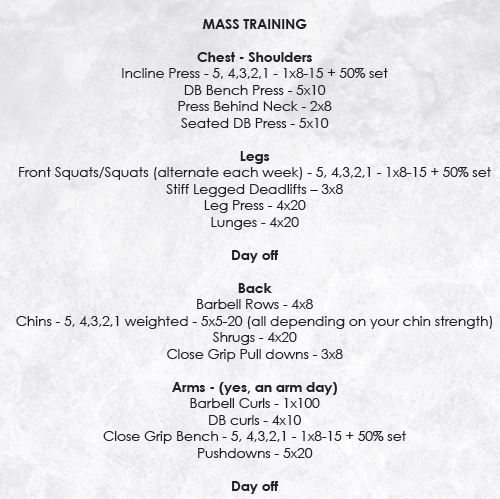
As you can see, the Mass Training phase essentially entails a bodybuilding style, body part split. The reps performed are in the 8-20 range for the most part. This period of the training is explicitly aimed at hypertrophy. Your main goal is to pick a weight that you can do for about eight reps and just stick with that weight until you can get closer to fifteen reps or so. You don’t even do deadlifts or the competition style bench on the default template provided. You only back squat every other week. Again, this period is purposefully a non-specific, bodybuilding oriented training block.
Base Building Period
The Base Building period is broken up into three different phases for each lift.
Each phase slightly reduces volume and increases overall intensity. While you can simply rotate through each phase, doing Phase I in Week 1, Phase II in Week 2, and Phase III in Week 3, Carter actually recommends that you stay in a phase for as long as possible. In his words, you stick with a phase until it becomes, “a joke…so easy that you have to up the intensity”. Outside of a competitive timeline, you could thus theoretically stay in the base building phase for months and months.
The squat base building phase features relatively light loads compared to the other lifts, but you’re expected to perform each lift with compensatory acceleration (CAT). In other words, no matter how much weight is on the bar, you’re supposed to lift it as fast and as hard as possible throughout the entire range of motion. You also have a time limit on the volume work. This is going to encourage improved work capacity and aid in hypertrophy.
The bench base building phase is a bit different. You have higher reps here and an AMRAP at the end of each workout. Carter, among many others, including myself, feels that the upper-body can handle a bit more overall stress and volume than the lower-body. As such, you’ll notice the prescribed work here is higher than for the other lifts.
When it comes to the deadlift, there aren’t necessarily phases, but there are different models based on how much you pull. You can see that for sub-500 pullers, you’re going to do a 5×3@80% each week (five sets of three). For 500-600 pullers, the overall volume is increased, but the intensity is lowered. Finally, for 600+ pullers, you lift on a rotation where you’re not actually going heavy every week. All of this is under the theory that the more you deadlift, the less often you can do it profitably.
Strong-15 Strength Peak Phase
Here is the peaking plan for a meet in Base Building:
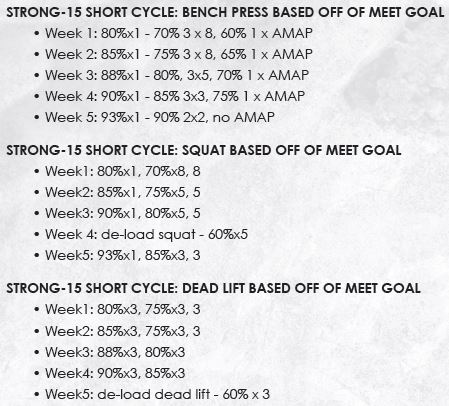
As you can see, in this phase, the volume is slowly tapered down while intensity is slowly cranked up. This helps accommodate the lifter to heavier loads while simultaneously allowing fatigue to dissipate ensuring a quality peak at the meet.
One thing worth noting is that you pull your last heavy deadlift two weeks out from the meet whereas the squat and bench are trained up until about seven days out from the meet.
Though it isn’t listed here, Week 6 is intended to be a complete deload.
Training Organization
You may have noticed that I didn’t lay out the training split for the programming. That is because Base Building offers literally a dozen or so training split options. There are full body templates and splits presented in the book. You’ll have to read it and decide what is best for you if you’re interested in the program.
Here is what Carter calls the “traditional” split:
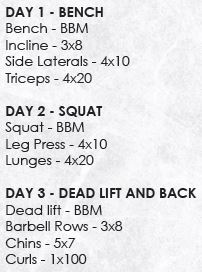
You can see that is a three times per week training schedule with each lift receiving its own dedicated training day. This is typical of many of Carter’s splits.
Periodization
In terms of periodization, as I said previously, the overall structure of base building is broken into three phases: muscular hypertrophy during “mass training”, work capacity/volume tolerance during “Base Building”, and maximal strength during the “strength peak”.
This is an advanced programmatic structure most suited for late stage intermediates and beyond. A novice can build muscle and strength simultaneously with ease and even Carter doesn’t suggest this template to beginners.
In my opinion, this is unnecessarily complex for early intermediate trainees as well. Intermediate trainees don’t need variation in emphasis from mesocycle to mesocycle. They merely need intelligent variation in volume and intensity (programming) from week to week to sustain progress. Periodization of this sort is unnecessary.
For advanced trainees, this is an intelligent structure for the most part. Advanced athletes need periods of emphasis on different qualities in order to maximize those qualities. Base Building has you bodybuild in the off-season, perform high volume, medium intensity work in the “pre-season”, and then you peak using low volume, high intensity work during “contest prep”.
Programming
Base Building does not employ traditional block programming per se, but it does feature a high volume, medium intensity phase (base building) followed by a low volume, high intensity phase (strength peak).
This is a very typical and highly appropriate way to vary intensity and volume for the intermediate trainee and beyond. The Base Building phase builds up your work capacity, volume tolerance, hypertrophy, and overall “baseline” performance. It does this through a high workload and workload is the primary driver of progress. Now, the strength peak phase essentially helps you transmute those gains into something that translates to an improved 1RM.
As for the “mass training” phase, well, if you look closely, this is an even higher volume, even lower intensity phase than “base building”. So, the programmatic structure is set up in a pendulum fashion from high volume, low intensity to low volume, high intensity.
This is an effective programmatic strategy. This is exactly what you have to do to make progress as an advanced athlete. Now this isn’t the only option for intelligent variation in intensity and volume, but it will work well for many lifters.
Specificity
Like many of the programs we’ve looked at, Base Building’s weakest aspect is specificity.
Many of you are going to vehemently disagree with me, but I don’t believe that it is ever necessary to include bodybuilding as part of your periodization plan as a powerlifter. I think this is where Carter’s non-powerlifting influences come into play.
The main driver of hypertrophy is total volume. Remember, intensity determines the training effect and volume determines the magnitude of that effect. Because virtually all intensities above a reasonable threshold are going to produce significant hypertrophy, the main determinant of how big your muscles grow is the total amount of reps you do. It is easier to do more total volume with lower intensities because this allows for higher reps per set. But, theoretically, if you just did more sets with lower reps, you’d get just about the same levels of hypertrophy. The only issue with this idea is that we have a limited amount of time to train. So, in order to get in massive volumes within their schedule, bodybuilders employ very high rep sets. If you only have an hour to be in the gym, it is more efficient to do five sets of 8-15 than it is to do 20 sets of 3 or something like that.
That said, as a powerlifter, this non-specificity is just not necessary. Mike Tuchscherer, owner of a 2100lbs+ raw, drug-free total does not program reps above 8 on the main lifts. Neither does Boris Sheiko (for the most part). If a powerlifter needs to gain muscle and move up a weight class, this can be efficiently accomplished with more volume and more eating. There is just no need for an explicit period of emphasis on bodybuilding style training – especially not a period where you drop deadlifts, regular flat benching, and frequent squatting.
In my opinion, even advanced powerlifters do not need to swing the pendulum this far towards hypertrophy… ever! It just takes them too far away from their sport.
Like most American programs, Carter, in my opinion, overemphasizes the importance of rowing and back work. I personally believe it is ridiculous to dedicate a full day to “back training” as a powerlifter. Some of Carter’s templates include twice weekly “back” workouts. Again, you get what you train for. If you want a big, powerful back, do lots of rows. If you want to squat, bench, and deadlift a lot, you’re better off doing lots of squats, benches, and deadlifts rather than spending time and resources on a full training session dedicated to your “back”.
Look, it isn’t that training your back is going to make you weaker; it is just that spending that time doing more squatting, benching, and deadlifting is going to do more overall to add to your total. We have to consider efficiency here. Doing back work certainly makes you stronger, and might be good for shoulder health, but it doesn’t add as much to your total as doing more work on the competition lifts. It is really that simple.
I also believe the squat training in the Base Building phase is too light. There is just too much volume at 60% here. It doesn’t matter if you put max effort on a bar loaded to 60%, you’re still not reaching maximal levels of force production. If you want to lift heavy weights, you have to lift heavy weights. This is the very core of specificity. You get what you train for. Will doing volume at 60% make you stronger? Sure. Will it make you as strong as doing more work at 80-90%? Probably not.
The rest of the program rates fairly well in terms of specificity. You’re doing most of your volume on the main lifts: squat, bench, and deadlift. There is some bodybuilding fluff throughout the program, but, again, the emphasis is on the main lifts and their close variants – as it should be.
Overload
Base Building uses a combination of progressive overload and adding reps to generate progress. Each phase progressively adds greater intensities forcing the lifter to handle heavier loads. The program also includes many times where AMRAP (as many as possible) sets are called for on back-offs and what not. You have many opportunities to set rep and weight PRs on the “base building” method.
That said, one of the great points that Carter makes throughout the book is that you can judge progress by metrics other than rep/weight PRs. Carter points out that if you did a triple at 500, and last time it was a grinder, but this time it was easy, that is progress. He’s right. In fact, this is basically RPE at work. If you do 500×3 at RPE 10 (no reps left), it is certainly substantial progress if you can now do 500×3 at RPE 8 (two reps left).
Carter uses the concept of “fatigue” singles and “over-warmups” for this purpose. You’ll notice that the program features a variety of singles before, or sometimes after, the main volume work for the day. These are always significantly heavier than your main work sets but still light enough to be easy considering the rep range asked of you. If these “over-warmups” and “fatigue singles” are getting faster, you know you’re getting stronger due to the decreasing RPEs at the same weights.
Fatigue Management
My first temptation is to criticize this program for not having enough frequency. As many of you know, I personally believe that lower frequency programs are harder to recover from, don’t offer as many chances for technical improvement, and produce less overall muscle gains than higher frequency templates. That said, I can’t truly levy this criticism because Carter offers full body templates in the book.
Overall, I feel the volume is a bit too low when you transition from the base building phase to the strength peak phase. During this phase, you often only have two work sets per week. If you’re using a once per week training template, which is what most of Carter’s are, this just isn’t enough unless you’re really beat up and supercompensating. In my opinion, most natural trainees need more than two or three work sets per week on each exercise. Unless you’re a very large athlete who is taking performance enhancing supplements, you’ll not only be able to recover from more, but you’ll need more to make optimal progress.
Further, even for advanced athletes, I don’t think it is ever necessary to deadlift heavy every other week. The idea that the deadlift is more recovery intensive than other lifts seems to exist mostly in the United States. Sheiko has his novice and intermediate trainees deadlift once per week. His advanced trainees deadlift two or three times per week.
Tuchscherer also often prescribes twice weekly deadlifting for the most advanced trainees. I think there are more intelligent fatigue management strategies than simply taking a full week off of one of the competition movements. If it is really necessary to do that, improving work capacity and volume tolerance should be made a priority rather than increasing the recovery time between sessions.
Taking so much time off from heavy pulling, in my opinion, sets you up for stagnation. Sure, when you pull heavy only twice a month, your recovery is better, but your work capacity and volume tolerance go to crap. Eventually, you’ll reach a point where the volumes you NEED to do, as a minimum, are too high for you to recover from because you just have no ability to recover from deadlifts anymore.
It’s a self-fulfilling prophecy my friend. You see, if you believe you can’t recover from more deadlifting, you won’t do more deadlifts. Your body then adapts to the workload you provide it and, over time, viola, you really no longer can do more deadlifting because your work capacity has dropped to match your programming. If you don’t use it, you lose it.
These criticisms aside, the overall structure of the program is sound. As long as you’re one of the people for whom this is enough volume to make progress, you shouldn’t have systematic recovery issues. Unlike say, Sheiko, this methodology errs on the side of too cautious and too minimal in terms of volume.
Individual Differences
Base Building addresses individual differences from a macro perspective, but mostly fails from the micro perspective. Let me explain. Throughout the book, Carter emphasizes that you need to find what works for you personally; he emphasizes that training is a long-term process that you slowly individualize over time. He offers a variety of templates and options for different demographics and powerlifters of varying training advancements. All of these things account for individual differences in the big picture, macro view.
However, session to session, workout to workout, the only autoregulation that is present is the ability to work up to your “EDM” on days when you feel great. In other words, the weights are always fixed. There is a tiny bit of volume autoregulation due to the AMRAP sets, but, again, the volume, for the most part, is fixed.
I think the reason that most popular programs use “training maxes” is because this is their attempt to account for variations in readiness and performance from day to day. They know that there are some days which are going to suck. So, they encourage programming from that base, minimum level. Instead of creating a system where you take advantage of what you can do on any given day, via autoregulation, the training max creates a system where you can still succeed even on the crappiest day because of how light the weights are. In this manner, the workouts are never so challenging that you can’t complete them even on your worst outing. But, at the same time, this takes away from the quality of your “average” and “great” days.
This is why I prefer Mike Tuchscherer’s RPE system. The RPE system allows you to autoregulate load in such a manner that you’re always working in the desired intensity range. We don’t have to program the weights needlessly low to ensure we don’t get screwed over by bad days. Likewise, when the good day rolls along, you can take advantage and a set PR. With Base Building, this autoregulation just isn’t present.
And as for volume, well you all know the story by now: everyone needs different levels of volume to produce the same training effect. We can know that two trainees did 5×5@75% but that tells us nothing about how the work actually affected them. If one of the trainees is 50 years old, he might be crippled for a week. If the other trainee is a 19 year old novice on a See-Food diet, well, he’ll be ready to go in 48 hours. Even the same trainee is going to need different volume based on how much sleep they got last night. With no autoregulation of volume, we just can’t be sure that our volume prescription is having the intended effect. Individual differences are too great. Volume must be regulated somehow.
Final Thoughts
I don’t want these reviews to come across as overly critical. I am not trying to shit on anybody’s work to stir up controversy here. I think Base Building is a novel and original work. I think that means a lot coming from me considering that I’ve now read dozens of these little programming eBooks over the past few weeks. Carter has a lot of good ideas and he has created a system that is all his own. I applaud his creativity. Overall, I think Base Building is rock solid.
That said, as a reviewer, I have to be critical of aspects that I personally feel are sub-optimal. I hope no one takes this as me saying that Base Building “doesn’t work”. When I point out what I perceive to be flaws, it is from the spirit of saying, “Hey, this could be further optimized”. It is NOT from the spirit of saying, “Hey, this program is a piece of shit”.
Like most American programs, I think Carter’s methodology includes way too much unnecessary emphasis on bodybuilding, too much emphasis on “back work”, too little frequency (for most templates), and a bit too little overall volume during some phases of the training program.
I think most natural trainees benefit more from templates that are higher volume, higher frequency. Study the training methods of top IPF lifters and see for yourself.
In conclusion, Base Building deserves a solid rating. It is a worthy program, but I personally believe that there are better options for raw powerlifters out there.
Did You Enjoy The ProgrammingToWin Series?
If so, you’ll absolutely love our eBook ProgrammingToWin! The book contains over 100 pages of content, discusses each scientific principle of programming in-depth, and provides six different full programs for novice and intermediate lifters. Get your copy now!
Like this Article? Subscribe to our Newsletter!
If you liked this articled, and you want instant updates whenever we put out new content, including exclusive subscriber articles and videos, sign up to our Newsletter!
Questions? Comments?
For all business and personal coaching services related inqueries, please contact me:
[contact-form-7 id=”3245″ title=”Contact form 1″]
Table of Contents
Powerlifting Programs I: Scientific Principles of Powerlifting Programming
Powerlifting Programs II: Critical Training Variables
Powerlifting Programs III: Training Organization
Powerlifting Programs IV: Starting Strength
Powerlifting Programs V: StrongLifts 5×5
Powerlifting Programs VI: Jason Blaha’s 5×5 Novice Routine
Powerlifting Programs VII: Jonnie Candito’s Linear Program
Powerlifting Programs VIII: Sheiko’s Novice Routine
Powerlifting Programs IX: GreySkull Linear Progression
Powerlifting Programs X: The PowerliftingToWin Novice Program
Powerlifting Programs XI: Madcow’s 5×5
Powerlifting Programs XII: The Texas Method
Powerlifting Programs XIII: 5/3/1 and Beyond 5/3/1
Powerlifting Programs XIV: The Cube Method
Powerlifting Programs XV: The Juggernaut Method
Powerlifting Programs XVI: Westside Barbell Method
Powerlifting Programs XVII: Sheiko Routines
Powerlifting Programs XVIII: Smolov and Smolov Junior
Powerlifting Programs XIX: Paul Carter’s Base Building
Powerlifting Programs XX: The Lilliebridge Method
Powerlifting Programs XXI: Jonnie Candito’s 6 Week Strength Program
Powerlifting Programs XXII: The Bulgarian Method for Powerlifting
Powerlifting Programs XXIII: Brian Carroll’s 10/20/Life
Powerlifting Programs XXIV: Destroy the Opposition by Jamie Lewis
Powerlifting Programs XXV: The Coan/Philippi Deadlift Routine
Powerlifting Programs XXVI: Korte’s 3×3
Powerlifting Programs XXVII: RTS Generalized Intermediate Program

